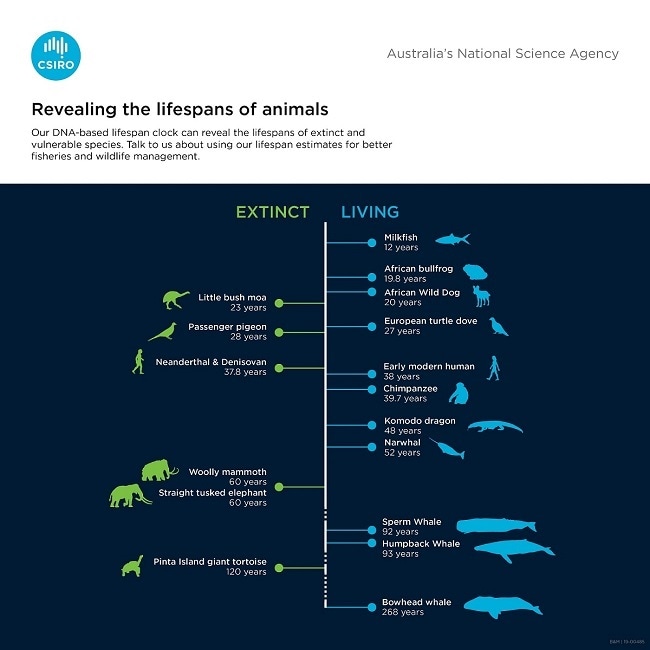Researchers at CSIRO, Australia’s national science agency, have discovered a simple way to estimate how long a species lives.

The above image summarizes some of the lifespan findings.
Using the human genome, the researchers found the maximum natural lifespan of humans is 38 years, which matches anthropological estimates of lifespan in early modern humans. This has been extended over the centuries by changes in lifestyle and more recently by advances in medicine.
The discovery has revealed the lifespans of extinct species such as woolly mammoths and Neanderthals. It also benefits fisheries and conservation management, which until now have relied on observing how long animals live in the wild.
Dr Ben Mayne, postdoctoral fellow with CSIRO's Environomics Future Science Platform, said understanding lifespan is critically important for conservation, biosecurity and wildlife management.
"Our method for estimating maximum natural lifespan is based on DNA. If a species' genome sequence is known, we can estimate its lifespan," Dr Mayne said.
"Until now it has been difficult to estimate lifespan for most wild animals, particularly long-living species of marine mammals and fish."
To calibrate their method, the researchers used genomes of animals with known lifespans from public databases such as NCBI Genomes and the Animal Ageing and Longevity Database.
Using our method, we found the maximum lifespan of the Bowhead whale is 268 years, 57 years longer than people thought.
We discovered that extinct woolly mammoths lived for 60 years and the recently extinct Pinta Island giant tortoise from the Galapagos lived for 120 years."
Dr Ben Mayne, postdoctoral fellow, CSIRO
To estimate lifespan for the extinct woolly mammoth, the researchers worked with a genome assembled from the genome of the modern African elephant, which lives for 65 years.
The genome of the Pinta Island giant tortoise is known from the last surviving member of the species, Lonesome George.
They found Neanderthals and Denisovans had a maximum lifespan of 37.8 years, similar to modern humans living around the same time.
"There are many genes linked to lifespan, but differences in the DNA sequences of those genes doesn't seem to explain differences in lifespan between different species," Dr Mayne said.
"Instead, we think that the density of a special type of DNA change, called DNA methylation, determines maximum natural lifespan in vertebrates.
"DNA methylation does not change a gene's sequence but helps control whether and when it is switched on.
"Using the known lifespans of 252 different vertebrate species, we were able to accurately predict lifespan from the density of DNA methylation occurring within 42 different genes.
"These genes are likely to be good targets for studying aging, which is of huge biomedical and ecological significance."
The research involved scientists from CSIRO and the University of Western Australia. The authors thank all individuals involved in the data creation, annotation and submission of the publicly available reference genomes used in this study.
Source:
Journal reference:
Mayne, B., et al. (2019) A genomic predictor of lifespan in vertebrates. Scientific Reports. doi.org/10.1038/s41598-019-54447-w.